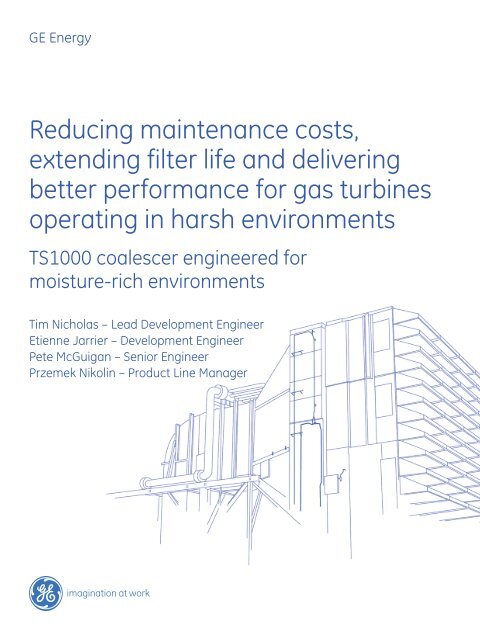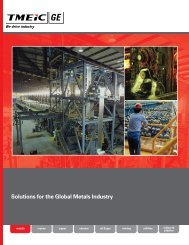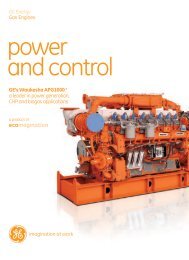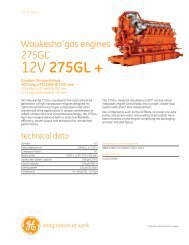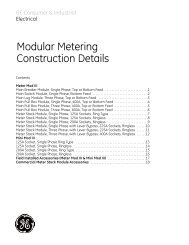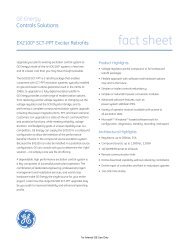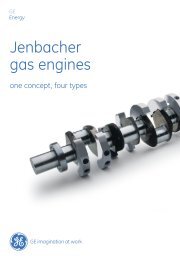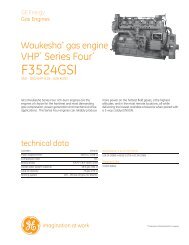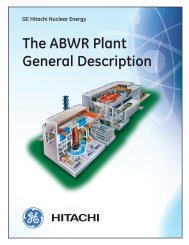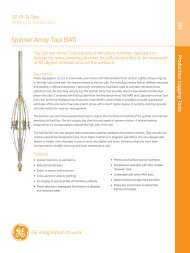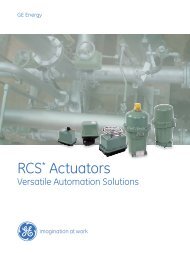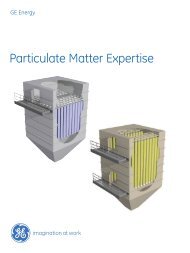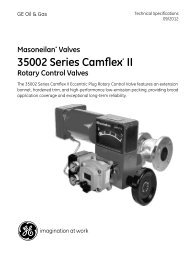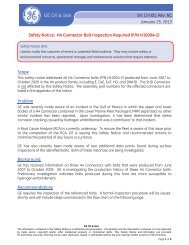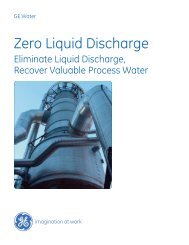Reducing maintenance costs, extending filter life and ... - GE Energy
Reducing maintenance costs, extending filter life and ... - GE Energy
Reducing maintenance costs, extending filter life and ... - GE Energy
Create successful ePaper yourself
Turn your PDF publications into a flip-book with our unique Google optimized e-Paper software.
<strong>GE</strong>A19789 TS1000_LR 3/12/12 3:36 PM Page 1<br />
<strong>GE</strong> <strong>Energy</strong><br />
<strong>Reducing</strong> <strong>maintenance</strong> <strong>costs</strong>,<br />
<strong>extending</strong> <strong>filter</strong> <strong>life</strong> <strong>and</strong> delivering<br />
better performance for gas turbines<br />
operating in harsh environments<br />
TS1000 coalescer engineered for<br />
moisture-rich environments<br />
Tim Nicholas – Lead Development Engineer<br />
Etienne Jarrier – Development Engineer<br />
Pete McGuigan – Senior Engineer<br />
Przemek Nikolin – Product Line Manager
<strong>GE</strong>A19789 TS1000_LR 3/12/12 3:36 PM Page 2<br />
<strong>Reducing</strong> <strong>maintenance</strong> <strong>costs</strong>, <strong>extending</strong> <strong>filter</strong> <strong>life</strong><br />
<strong>and</strong> delivering better performance for gas turbines<br />
operating in harsh environments<br />
Introduction<br />
Coalescers help to remove moisture from the air stream, which protects the<br />
downstream <strong>filter</strong>s <strong>and</strong> the turbine. This is essential in environments with high<br />
levels of ambient moisture; humidity, rain, fog <strong>and</strong> mist. Coalescers can also help<br />
to remove liquid phase corrosives, reducing the likelihood of them reaching the<br />
turbine <strong>and</strong> causing damage.<br />
Coalescers remove moisture by agglomerating water droplets,<br />
making them larger <strong>and</strong> heavier. This allows a large proportion of<br />
the droplets to drain away rather than continue in the airstream,<br />
which helps avoid these two problems:<br />
• Small liquid droplets allowed to travel downstream can<br />
become embedded between the <strong>filter</strong> ‘pleats,’ which are the<br />
current st<strong>and</strong>ard design for high efficiency <strong>filter</strong> product. This<br />
impediment to the air can lead to differential pressure ‘spikes.’<br />
For environmental conditions such as fog, that can lead to an<br />
accelerated differential pressure increase <strong>and</strong> gas turbine alarm<br />
<strong>and</strong> trip levels being rapidly reached.<br />
Fog, fine<br />
water particles<br />
Air flow direction<br />
Coalescer media fibers<br />
Coalesced droplets<br />
• In addition, small liquid droplets can help form ‘mud.’ This<br />
can happen because of: 1) the associated increase in residence<br />
time, due to the small liquid droplets being embedded within<br />
the pleats rather than flowing vertically down <strong>and</strong> away;<br />
<strong>and</strong> 2) the high total droplet surface area associated with<br />
a large quantity of small liquid droplets provides for greater<br />
interaction with any accumulated dust.<br />
In either case—<strong>and</strong> especially with mud—it’s common to see a<br />
differential pressure ‘spike.’ Unfortunately, the use of a compressed<br />
air pulsing system has a limited effect. The system would have<br />
to exceed normal operating limits to obtain the inertial forces<br />
required to overcome the surface <strong>and</strong> frictional effects present<br />
<strong>and</strong> adequately remove the embedded liquid <strong>and</strong>/or sticky dust.<br />
Fine water droplets<br />
coalesce into<br />
bigger droplets<br />
Gravity force<br />
Dust particles<br />
Figure 1. Coalescers remove moisture by agglomerating water droplets, making them<br />
larger <strong>and</strong> heavier, droplets then fall from the airstream protecting the downstream<br />
<strong>filter</strong>s <strong>and</strong> the turbine.<br />
<strong>GE</strong> <strong>Energy</strong> | <strong>GE</strong>A19789 (02/2012) TS1000 coalescer engineered for moisture-rich environments 2
<strong>GE</strong>A19789 TS1000_LR 3/12/12 3:36 PM Page 3<br />
<strong>GE</strong>’s TS1000 Low-Maintenance Coalescer<br />
Whether the trouble stems from dust, fog or s<strong>and</strong>, power plants in moisture-rich<br />
environments need a low-<strong>maintenance</strong> solution with coalescers to protect both the <strong>life</strong><br />
of the high efficiency <strong>filter</strong>s <strong>and</strong> the performance of the gas turbine. That’s why heavyduty<br />
gas turbines can benefit from a new, low-<strong>maintenance</strong> coalescer—<strong>GE</strong>’s TS1000.<br />
The TS1000 delivers good overall coalescing performance with low pressure drop, low <strong>maintenance</strong> <strong>and</strong> long service <strong>life</strong>. In recent tests,<br />
the TS1000 lasted about three times longer than other coalescers before needing to be cleaned. When it does need a cleaning, the work<br />
is much easier <strong>and</strong> quicker because it can be done without removing the TS1000. And when cleaned correctly, the TS1000 should return<br />
to its original efficiency <strong>and</strong> pressure loss.<br />
Compare the <strong>GE</strong> TS1000 with other coalescers:<br />
TS1000 Coalescer with Moisture Separator<br />
S<strong>and</strong> <strong>and</strong> dust pass through the TS1000 coalescer with the<br />
moisture separator after 12 months in operation<br />
Coalescer does not clog with dust <strong>and</strong> s<strong>and</strong> as quickly due to the<br />
patent pending media<br />
Other Coalescers<br />
This coalescer was clogged with dust <strong>and</strong> the <strong>filter</strong>s were forced<br />
out of place, air was then passed through without being coalesced<br />
Filters clogged with s<strong>and</strong> <strong>and</strong> dust get forced out of place, air<br />
passed through without being coalesced<br />
<strong>GE</strong> <strong>Energy</strong> | <strong>GE</strong>A19789 (02/2012) TS1000 coalescer engineered for moisture-rich environments 3
<strong>GE</strong>A19789 TS1000_LR 3/12/12 3:36 PM Page 4<br />
Here’s more on how the TS1000 is superior to today’s coalescers,<br />
<strong>and</strong> how tests show it works better:<br />
The problem with today’s coalescers<br />
Coalescer media have historically been similar to those employed<br />
for dust filtration. As a result, while wishing to capture only liquid<br />
moisture, they also naturally tended to capture dust. This often<br />
causes block up, a differential pressure increase <strong>and</strong>, in high<br />
dust environments, three other problems: constant monitoring,<br />
frequent <strong>maintenance</strong> <strong>and</strong> frequent coalescer replacement.<br />
For example, in a typical, self-cleaning <strong>filter</strong> house, the high<br />
efficiency cartridge <strong>filter</strong>s are protected from the elements by<br />
weather hoods. (See Figure 2.) This arrangement, though, provides<br />
Transition<br />
Evaporative<br />
cooler<br />
Filter house<br />
Weather<br />
hood<br />
basic protection only against big, heavy rain droplets. It does not<br />
protect <strong>filter</strong>s against exposure to fine <strong>and</strong> light fog droplets.<br />
Exposure of the <strong>filter</strong> elements to fine water particles in the form<br />
of fog will lead to wet <strong>filter</strong>s <strong>and</strong> reduced <strong>filter</strong> <strong>life</strong>, manifested<br />
as high differential pressure across the <strong>filter</strong>s <strong>and</strong>/or the gas<br />
turbine alarm being reached. If the high efficiency <strong>filter</strong> is not<br />
hydrophobic (not moisture repellent), then in addition, moisture<br />
droplets (potentially containing salts) will leach through the <strong>filter</strong>s.<br />
The end result may be power output reduction, unplanned<br />
shutdown <strong>and</strong> eventually damage or even catastrophic failure<br />
of compressor <strong>and</strong> turbine components.<br />
Coalescers on the market today exhibit problems such as:<br />
• They require frequent replacement, <strong>and</strong> the downtime involved<br />
in replacing can be extensive.<br />
• They are very difficult to clean <strong>and</strong> do not return to their original<br />
efficiency <strong>and</strong> pressure loss.<br />
• Often the dust <strong>and</strong> s<strong>and</strong> deposits become so great, they increase<br />
the pressure loss across the coalescer. When that happens, it<br />
triggers a “pressure release” mechanism, <strong>and</strong> the coalescer pops<br />
up. This allows air to pass through without being coalesced –<br />
removing the protection against fine droplets.<br />
Figure 2. Self-cleaning <strong>filter</strong> house without moisture separator <strong>and</strong> TS1000 coalescers<br />
What’s different about the TS1000?<br />
To reduce the risks mentioned in the previous section, <strong>GE</strong><br />
recommends that all sites within 12 miles from any body of<br />
water should use weather hoods with two stages of water<br />
removal system. (See Figure 3.)<br />
The first stage is a moisture separator (Figure 4) with coalescing<br />
efficiency down to 50 microns. The second stage is a TS1000<br />
coalescer (Figure 5) that has a 99 percent coalescing efficiency<br />
for water droplets down to 10 microns. It captures <strong>and</strong> coalesces<br />
Weather hood<br />
Coalescing <strong>filter</strong><br />
Moisture separators<br />
Figure 3. A weather hood with two stages of water removal<br />
Figure 4. Moisture separators, efficiency<br />
down to 50 microns<br />
TS1000<br />
Figure 5. TS1000, efficiency for water<br />
droplets down to 10 microns<br />
<strong>GE</strong> <strong>Energy</strong> | <strong>GE</strong>A19789 (02/2012) TS1000 coalescer engineered for moisture-rich environments 4
<strong>GE</strong>A19789 TS1000_LR 3/12/12 3:36 PM Page 5<br />
moisture, but has limited dust removal capabilities. Combining the<br />
stages within the weather hood help the coalescing <strong>and</strong> pressure<br />
loss characteristics of the TS1000, which remain optimized in both<br />
wet <strong>and</strong> dry conditions.<br />
The reason the TS1000 works better is that the <strong>GE</strong> team developed<br />
a new technology that uses a different media—100 percent<br />
synthetic high performance woven mesh—<strong>and</strong> gets different results.<br />
It has very low dust removal efficiency. Even as it catches small<br />
liquid droplets, combines them with larger ones <strong>and</strong> then drops<br />
them out of the airstream, the TS1000 allows bypass of s<strong>and</strong><br />
<strong>and</strong> dust.<br />
The TS1000 is also easily cleaned. Without being removed, low<br />
pressure cold water or compressed air should restore the <strong>filter</strong><br />
to near original efficiency <strong>and</strong> pressure loss. This helps maintain<br />
output <strong>and</strong> excellent service <strong>life</strong> performance.<br />
Figure 6. TS1000 can be washed in place, decreasing <strong>maintenance</strong> time dramatically<br />
“The TS1000 has excellent fine mist/fog removal effectiveness<br />
with significantly low dust removal efficiency,” said Tim Nicholas,<br />
<strong>GE</strong> <strong>Energy</strong>’s Lead Development Engineer. “It provides superb<br />
performance during the fog season with low risk of clog during<br />
a s<strong>and</strong> storm. In the end, it requires much less attention from the<br />
operator <strong>and</strong> helps reduce the <strong>maintenance</strong> to a minimum.”<br />
Field tests<br />
The TS1000 offers a simple design, robust construction <strong>and</strong> it fits a<br />
range of new <strong>and</strong> retrofit configurations. To gauge its effectiveness,<br />
<strong>GE</strong> sent it to the Middle East for 12 months, where it was exposed to<br />
natural contaminants, extreme fog <strong>and</strong> dust storm conditions.<br />
Afterward, <strong>GE</strong> further analyzed high efficiency final <strong>filter</strong>s returned<br />
from the field to see how they would react to mist in a laboratory<br />
test chamber. Throughout the laboratory testing, measurements<br />
of differential pressure were taken across the high efficiency <strong>filter</strong>.<br />
Different configurations of <strong>filter</strong> protection were added <strong>and</strong> the test<br />
was re-run, showing the <strong>filter</strong> reaction with moisture separator<br />
upstream <strong>and</strong> the effect of the TS1000.<br />
The chart in Figure 7 reflects the results of the <strong>filter</strong> performance<br />
testing.<br />
• Line one shows the reaction to mist of a final <strong>filter</strong> without<br />
a moisture separator or coalescer.<br />
• Line two shows a reduced reaction with the addition of a<br />
moisture separator upstream of the final <strong>filter</strong>.<br />
• Line three shows performance with the TS1000 coalescer<br />
<strong>and</strong> the moisture separator upstream of the final <strong>filter</strong><br />
across seven hours of fog exposure. The differential<br />
pressure immediately begins to trend upward when the<br />
TS1000 was removed. (See the orange line.)<br />
Pressure Loss (inch w.g.)<br />
7<br />
6<br />
5<br />
4<br />
3<br />
2<br />
1<br />
0<br />
Returned Field Filter vs Mist<br />
1 2<br />
Turbine Alarm Point<br />
Removal of TS1000 coalescing<br />
<strong>filter</strong> showing <strong>filter</strong> reaction to mist<br />
1. Dirty Filter without TS1000 <strong>and</strong> Moisture Separator<br />
2. Dirty Filter with Moisture Separator<br />
3. Dirty Filter with TS1000 <strong>and</strong> Moisture Separator<br />
3<br />
Figure 7. Gauging effectiveness in the Middle East<br />
<strong>GE</strong> <strong>Energy</strong> | <strong>GE</strong>A19789 (02/2012) TS1000 coalescer engineered for moisture-rich environments 5
<strong>GE</strong>A19789 TS1000_LR 3/12/12 3:36 PM Page 6<br />
On-site monitoring<br />
<strong>GE</strong> also ran two units side-by-side on site, the TS1000 paired with a<br />
competitor’s coalescer. The installed high efficiency <strong>filter</strong>s were<br />
aged similarly; the only difference—the coalescing technology.<br />
7<br />
6<br />
TS1000 vs Competitior B in S<strong>and</strong> Storm Conditions<br />
Competitor Replacement Competitor Replacement<br />
Turbine Alarm Point<br />
TS1000 Wash<br />
A s<strong>and</strong> storm ripped through the area during July 2011, <strong>and</strong> as<br />
the system differential pressure was monitored, it showed how<br />
well the TS1000 performed.<br />
• <strong>GE</strong>’s TS1000 coalescer lasted 2.5 times longer than its<br />
competitor during the event.<br />
Filter House Dp (inch w.g.)<br />
5<br />
4<br />
3<br />
2<br />
• The turbine with the competitor’s coalescer reached the Turbine<br />
Alarm Point twice, <strong>and</strong> the coalescer needed to be replaced.<br />
• The TS1000 needed to be washed with water only once—just<br />
before the competitor’s coalescer was about to be replaced for a<br />
third time.<br />
1<br />
0<br />
TS1000<br />
Competitor<br />
NOTE: The dotted blue line in the chart indicates a prediction based on performance prior to<br />
time of removal. Actual data not available because the coalescers were removed <strong>and</strong> needed<br />
to be replaced.<br />
Figure 8. <strong>GE</strong>’s TS1000 demonstrated longer <strong>life</strong> in recent tests<br />
• When the TS1000 reached the Turbine Alarm Point, it was<br />
washed in place without being removed.<br />
Fog event<br />
In December 2011, <strong>GE</strong> went to the same site in the Middle East <strong>and</strong><br />
paired the TS1000 with a competitor product during a fog event.<br />
Again <strong>GE</strong> ran two units side-by-side for both pulse <strong>filter</strong>s <strong>and</strong> 3rd<br />
stage filtration with similar numbers of fired hours on the <strong>filter</strong> set.<br />
The only difference: the coalescing technology.<br />
And again, the TS1000 performed much better than its competition.<br />
Table 1 shows change in pressure drop in inch water gage <strong>and</strong><br />
shows an increase in pressure loss during the fog event on each<br />
filtration stage. The measurements were taken at the same point<br />
in time, during the fog event, at the most dramatic levels.<br />
“For both pulse <strong>filter</strong>s <strong>and</strong> 3rd stage filtration,” said one customer,<br />
“it was clear the TS1000 was more effective than the other<br />
coalescing <strong>filter</strong>. This is what we need in order to have less<br />
<strong>maintenance</strong>, to have a longer operating <strong>life</strong> <strong>and</strong>, in general,<br />
to be more effective.”<br />
Differential pressure during fog event December 2011<br />
Unit with<br />
TS1000<br />
Unit with<br />
competition<br />
Coalescer<br />
inches WG measured across each <strong>filter</strong> stage<br />
coalescer<br />
Table 1. Performance during the fog event<br />
pulse<br />
<strong>filter</strong>s<br />
3rd stage<br />
system<br />
0.3 0.3 0.2 0.8<br />
0.9 0.8 0.1 1.8<br />
<strong>GE</strong> <strong>Energy</strong> | <strong>GE</strong>A19789 (02/2012) TS1000 coalescer engineered for moisture-rich environments 6
<strong>GE</strong>A19789 TS1000_LR 3/12/12 3:36 PM Page 7<br />
Summary<br />
The TS1000 helps maintain gas turbine inlet air quality,<br />
whether the harsh environment produces dust, fog<br />
or s<strong>and</strong>. Not only does it improve overall coalescing<br />
performance, it also delivers low pressure drop, requires<br />
low <strong>maintenance</strong> <strong>and</strong> extends service <strong>life</strong>. In recent<br />
tests, the TS1000 went about three times longer than<br />
other products tested before needing to be cleaned, <strong>and</strong><br />
when it did need a cleaning, the work was quicker <strong>and</strong><br />
extended the <strong>life</strong> of the coalescer for up to 12 months.<br />
For more information, please call 1-800-476-9912,<br />
visit http://www.ge-energy.com/gtis or email<br />
filtration@ge.com.<br />
©2012, General Electric Company. All rights reserved.<br />
<strong>GE</strong>A19789 (02/2012)


